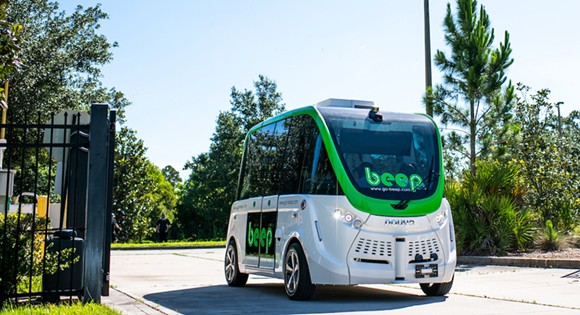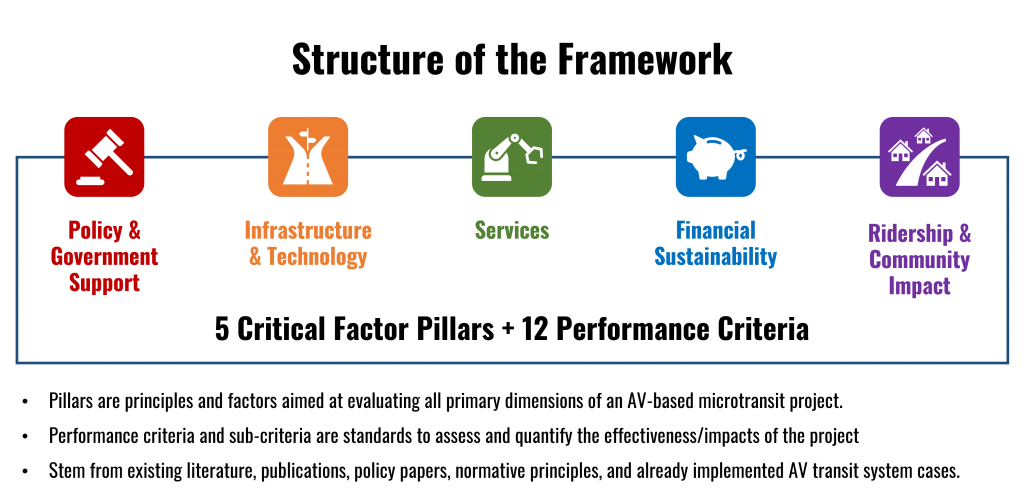
Principal Investigator: Zhong-Ren Peng (University of Florida)
Project Manager: Paul Schoelzel (Florida Department of Transportation)
Overview
A number of studies have speculated the impact of AVs, especially in traffic safety enhancement and the improvement of passenger mobility given today’s decreasing travel costs and increased convenience (“Blueprint for Autonomous Urbanism,” 2017; Kohlstedt, 2017; Soteropoulos et al., 2019). According to published reports, AVs are the hope for enhancing road safety, reducing freight costs, minimizing parking in cities, and improving mobility (“Taming the Autonomous Vehicle,” 2017). However, some concerns and doubts still exist; whether rideshare and microtransit AVs increase travel demand, thus producing greater congestion, as well as the potential effects on public transit ridership remain unanswered (Fagnant & Kockelman, 2013; Weinberg, 2017).
Automated Vehicles (AVs) have evolved from conceptual devices to prototypes, and currently are being tested on public roads with freight and passengers, particularly for level 3 and above based on SAE standards for driving automation. The technology offers a great promise to enhance transit services, reduce operation costs and attract new riders. But implementation is not easy, and there may be unforeseen issues and problems in the planning and implementation process. Furthermore, there is also a lack of quantifiable benefits or impacts from existing AV-based microtransit services.
Moreover, recent studies on AV mobility have shown that AV deployment in urban areas may reduce 80% of private cars, but this is only possible if AVs appear in a ride-share scenario (UITP, 2016). In response, manufacturers have been more likely to produce electric-powered vans and minibusses with a passenger capacity of around 10 to 30. This size allows AVs to serve as either fixed-route buses or on-demand microtransit (Easymile. 2017, Navya. 2017, Tuvie. 2017). Various studies (Center for Advanced Multimodal Mobility Solutions and Education, 2019) have analyzed possible use cases for AV-based transit, such as first-mile and last-mile connections to existing public transportation services; community circulators; mobile desert areas (locations difficult to integrate and promote active transportation through traditional transportation services). And while many of these studies have remained speculative, through cost-benefit assessment and simulation, relevant guidelines and criteria have been developed such as: goal setting for automation technology, technology and supplier evaluation, business planning and monitoring, technology implementation and deployment, route preparation, and consumption identification.
For instance, the Center for Advanced Multimodal Mobility Solutions and Education (2019) proposed a project to mitigate delays experienced by occupied vehicles by minimizing the impact of empty AV route choice. Additionally, Mobility e3 LLC (2019) has developed guidance for transit agencies and communities on the development and deployment of Low-Speed Automated Vehicles pilots. Even government entities such as the Nevada Department of Transportation have proposed a project tasked with developing methods to qualitatively assess the feasibility of the business/funding case. Yet, few research efforts aim to solve transit and pedestrian safety problems (Odell, Wade et al.,2019), such as developing, designing, testing, piloting, and deploying candidate applications through an AV/CV Test Bed.
Significance
Thus far, existing studies are comprised of predictions and speculation, without actual case and data support. Select guidance, although based on theoretical underpinnings, does exist regarding the implementation of AV systems in a testbed. However, this guidance lacks documentation of applied implementation issues, challenges, and lessons learned. To this point, there is an urgent need to conduct a study on the implementation of a non-hypothetical case before the AV-based microtransit system is fully deployed. This early engagement will prove highly beneficial when developing a comprehensive systematic assessment after implementation.
In Florida, a great opportunity has arisen to document the challenges and opportunities present during the planning and implementation process of an AV-based micro-transit system. In November 2019, Orange County won a $20 million grant from the U.S. Department of Transportation to create a Local Alternative Mobility Network (LAMN) to provide better mobility options in order to reduce the dependency on cars in southeast Orlando’s Lake Nona community. The grant will support the planning, design and construction of critical infrastructure components like shared mobility lanes and 20 self-driving vehicles. This is a huge investment for AV-based microtransit in the state of Florida, and a rare opportunity to collect baseline data and develop the evaluation framework necessary to quantify impacts post-deployment. Findings from this work will equip transit agencies and decision-makers, both statewide and nationally, with non-hypothetical lessons learned to aid in future A/V system development.
Project Objectives
The success of this federal-funded BUILD (Better Utilizing Investments to Leverage Development) grant project (hereafter BUILD grant) will have important impacts on future AV-based microtransit development in the state of Florida. Therefore, it is important to document the full planning and decision-making process and collect baseline information in the Orange County area prior to implementation.
Though many studies have been conducted to assess the impact of AVs or AV-based microtransit, few research efforts have examined preliminary implementation challenges as well as the real-life benefits or drawbacks of an AV-based micro-transit system. This proposed research project will address some fundamental questions such as:
- What is the full scope of work necessary to successfully implement an AV-based microtransit system?
- Analysis will include organizational, infrastructure, safety, technology, and financing challenges and concerns.
- What are the impacts on mobility improvement and community livability based on a set of performance measures including but not limited to transit ridership impacts (e.g., mode shift, ridership changes, and service satisfaction), residents perceptions of safety and neighborhood livability, and impacts on transit agencies’ operation (e.g., operation management, maintenance, and budget implications)?
The diagram below presents the AV-based microtransit project’s evaluation framework.
